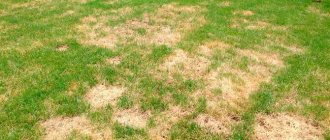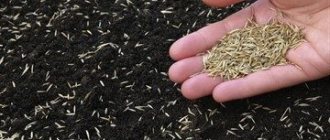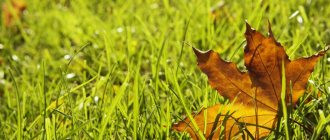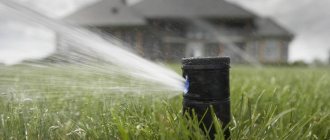When is the last time to mow the grass before winter? Last time mowing the lawn in the fall
Throughout the warm season, you have to take care of your lawn.
One of the most troublesome tasks is mowing the lawn. It has to be carried out once every 7–10 days, depending on the soil temperature, its composition and humidity. The closer winter gets, the colder the air, and therefore the soil. Therefore, the growth rate is significantly reduced. And some lawn owners think that they can avoid mowing their lawn for the winter and stop paying enough attention to it. This is a serious mistake. The grass, although slowly, continues to grow. As a result of this, the grass grows back, withers from the first cold weather and lies on the ground, covering it with a thick carpet.
Frozen grass lies on the ground
It would seem that there is nothing wrong. But in the spring, withered grass can become an obstacle to young grass, significantly reducing its growth rate, which certainly will not please any site owner. When is the last time of the year to mow the grass? Alas, it is impossible to give definite advice here. Everything depends not only on the region and climate, but also on the weather in a particular year. So just make sure that the grass is not too long.
If it reaches a length of 7-8 centimeters, go over it with a mower.
When cool nights arrive, the grass grows very rarely, so the area will have to be mowed very infrequently. However, you should not be zealous in any case. Do not cut the grass shorter than five centimeters. Otherwise, you risk leaving your grass completely without the nutrients it will need to quickly recover in the spring. If autumn turns out to be unusually warm, and the grass has time to grow again to 7-8 centimeters, repeat mowing the lawn.
Don't hesitate whether to cut the grass or leave it long enough. It’s better to let it overwinter a little shorter than too long. This defect will correct itself, and quite quickly. But in the spring you will have to remove the abundant, dried out and half-rotten grass yourself.
What to do with cut grass? There are two options here. You can send them to the compost heap, or simply scatter them over the beds from which the harvest has already been harvested (if any). Tender, fresh lawn grass will rot quite quickly, and in the spring you will receive fresh humus, which will become an excellent fertilizer for planted plants. In the latter case, you will not have to first drag the grass to the compost heap, and then, in the spring, to the beds.
An example of a rotted lawn grass root
Don't worry about the grass on your lawn drying out. Daily temperature changes usually provide abundant dew formation, which will be quite enough for the grass. Of course, if the temperature suddenly rises to +30 degrees in the shade at the end of September, you can water the lawn a little. But this happens extremely rarely.
Content
- 1. Why are lawns mowed?
- 2. How to properly mow the lawn for the first time?
- 3. Lawn mowing in spring, autumn and summer + basic rules 3.1. How high should I mow my lawn?
- 3.2. When to mow the lawn after winter?
- 3.3. How often should I cut my lawn grass?
- 4.1. Uneven surface
Read about choosing a lawn mower in our separate large review: “How to choose a lawn mower?”
Mowing the lawn is the very technique that allows you to maintain it in the form of a thick, perfectly even green carpet. Mowing the top of the plants stimulates their branching, new shoots grow fluffy and bright, making it more difficult for weeds to break through them.
Is it necessary to mow the grass in the fall? How to prepare your lawn for winter?
Every autumn, any summer resident and gardener prepares his plot for wintering. At the same time, don’t forget about the lawn. This green lawn needs care even more than ordinary garden and garden plants.
It is very important to stop watering in time. As a rule, there is sufficient rainfall in September. Nature will give the grass enough moisture, so the frequency of watering in September is reduced. And in mid-October, watering can be completely stopped.
The preparation for winter itself is carried out in several stages. Namely:
- First of all, you need to pick up a rake, preferably a fan one. This tool thoroughly cleans lawn areas of debris, dry leaves and withered grass;
- Next, you need to mow the lawn. Many people have noticed that grass grows slower in autumn. Therefore, you need to mow less often than in summer. The most important thing is that in winter the grass on the lawn should not be higher than 5-7 centimeters. When is the last time you mow? In the middle zone of our country, the last haircut is carried out in early October. After this, the lawn will no longer grow. But this rule does not apply to the southern regions. Here the temperature remains warm for a long time, so haircuts should be carried out as needed. Don't forget to remove any lawn clippings. If you leave it, then excellent conditions will be created on your site for the reproduction of various small rodents. And these animals will greatly damage your neat and beautiful lawn;
- The next step in preparing for wintering will be soil aeration. This operation is necessary for soil drainage and air delivery to the rhizomes. Aeration itself is not difficult. It is enough to take a garden fork and pierce the soil under the lawn grass to a depth of 30 centimeters. Such punctures are made at intervals of 30-40 centimeters. When carrying out aeration, it is advisable to raise the soil slightly, so more fresh air will reach the roots. After this operation, you should not walk on the lawn for two to three days. But there is one nuance here. If the soil is sandy, then aeration may not be necessary. Such soils themselves conduct water and air perfectly.
- Also during this period, fertilizers are applied to the soil. As a rule, these will be phosphorus-potassium compounds. It is worth remembering that after applying such fertilizers, it is imperative to water the lawn grass. If this is not done, phosphorus-potassium compounds can burn the plants.
Winter care tips
But preparing the site for winter is not all there is to worry about. To ensure that your lawn pleases you with greenery next year, you should take care of this during the winter cold. Otherwise, in the spring, instead of a neat lawn, you will have an area with sparsely growing grass .
Firstly, in winter you should not walk through the area where lawn grass is planted. At least, experts do not recommend doing this until the layer of snow becomes 15-20 centimeters thick.
Secondly, you cannot store a lot of snow from neighboring areas on the area where lawn grass grows. This additional stress can damage the grass. In this case, in the spring you will have to spend additional money on buying seeds and wait a long time for the new grass to catch up with the old one.
In addition, you need to monitor the formation of an ice crust on the area. Very often, especially in the southern regions, after a thaw a layer of ice forms on the surface. If this happens to an area allocated for a lawn, then you need to get rid of the crust quickly. This layer of ice will prevent air from reaching the grass. For the same reason, it is not recommended to fill the skating rink in areas where lawn grass grows.
Particular attention should be paid to lawn grass in the spring. The plants have just begun to recover from the winter cold and are very weak, so during this period they need support. First of all, fertilizers are applied to the soil. After this, after the snow has completely melted, you need to thoroughly comb the grass. This will provide access to fresh air.
When the grass stops growing. TO WHAT HEIGHT SHOULD I CUT THE GRASS?
Although constant removal of leaves is not critical for lawn grasses and cutting is not life-threatening, it should still be remembered that this is quite a significant stress. Cutting points become “gateways” for diseases, through which the grass intensively loses moisture. Therefore, in order for plants to recover quickly and painlessly, they should not be shortened by more than 1/3 of their length at a time, and after mowing, they should be watered and fed abundantly.
If the grass is cut irregularly and too low, it will quickly weaken and weeds and mosses will appear on the lawn. If the plants are not mowed low enough, side shoots will not actively form and the grass cover will be sparse and patchy. In addition, the lower part of the leaves and stems will turn pale due to lack of sunlight and the lawn will also become spotted.
The optimal grass height depends on the purpose of the lawn being grown, its condition at the time of cutting and age.
In the legendary English parterre lawn in its homeland, the grass height is only 1 - 2 cm. However, in our climatic conditions, mowing to such a height will lead to the formation of a hard grass cover and drying out. For our parterre lawns, we use the so-called European style with a grass height of 3 - 4 cm.
A decorative garden lawn is mowed to a plant height of 4–7 cm. If the lawn is functional (also used for games, barbecues/barbecues, sunbathing, etc.), then the grass on it should be left 4–6 cm high.
Sports lawns intended for playing football, field hockey or rugby are sown with trampling-resistant grasses and mowed to a height of 3 - 4 cm. Lawns on golf courses, depending on the location, are sown with various mixtures of grasses and cut at different heights. They are serviced by experienced experts in their field.
In summer, when the weather is dry and hot, the cutting height of the grass should be slightly increased. This increases soil shading and reduces drying out.
The height of the first mowing of a young lawn should not be lower than 8 - 10 cm. Subsequently, within two years, the grass on functional and decorative garden lawns is mowed to 5 - 7 cm, and on ground lawns - to 4 - 5 cm.
If for some reason the grass cover on the lawn has reached a height significantly higher than the norm, it should not be brought to the required height in one go. As mentioned above, no more than 1/3 of the plant's length can be removed at a time. That is, several haircuts will be required to get the lawn in order.
Cover the soil with mulch
Layers of plant residues, preventing sufficient ventilation of the lawn, provoke the development of dampness, as a result of which various diseases appear.
In the autumn, it is also necessary to promptly clear the lawn of fallen leaves, old grass and other debris using a fan rake or broom
Autumn is a favorable time to smooth out any unevenness in the lawn that arose during the summer months
The composition of the mulching mixture is determined by the characteristics of the soil on the site. The best option is a mixture consisting of equal parts of earth, peat and sand.
In order to increase the fertility of the land depleted over the season, the entire area of the lawn can be covered for the winter with a layer of peat mixed with dry compost.
The bulk of lawn care work occurs in the spring: repairing bald spots, reseeding grass, removing debris accumulated over the winter, decorating the edges of the lawn, etc. Caring for lawn grass in the fall will help you significantly reduce the hassle of spring, as well as protect your plants during the most unfavorable period for them.
Mulching the lawn for the winter. Mulching the lawn
Lawn care includes several important components - combing, watering, fertilizing, mowing, aeration, but mulching should be one of the first places on this list. Prolonged rains, droughts, gusts of wind and other unfavorable natural factors test the strength of beautiful green lawns and do not always keep their surface in good condition. If its integrity is violated, nutrients from the soil are quickly washed out, the root system of plants weakens, and the grass cover loses its decorative qualities. Mulching will prevent negative changes in the appearance of the lawn, as it can:
- Control the circulation of water in the soil and improve air exchange;
- On hot summer days, reduce the level of moisture evaporation from the soil;
- The increased thickness of the turf layer makes it more durable and hardy;
- Influence the accelerated growth of young shoots;
- Maintain the decorative appearance of the lawn surface and level it;
- Increase the level of its resistance to various natural changes and weather vagaries many times over.
How and with what to mulch the lawn
Most often, lawn mulching is done in two main ways. The simplest one is to leave mowed and well-shredded grass on the surface of the green lawn. A thin layer of this grass mulch of approximately the same thickness should cover the entire surface of the lawn. It is very important that the mowed grass is thoroughly chopped, without the remains of large stems and leaves. If the lawn is mowed regularly, then there will be no problems with such a mulch coating.
The mulch layer should not be made thick and dense. When grass clippings are repeatedly added to the lawn over a season, the mulch will become airtight and can be a source of infection and the spread of fungal diseases. This will be facilitated by prolonged heavy rains, which will lead to rotting of the grass covering and infection of young plants by bacteria and fungi. To prevent this, it is recommended to rake the accumulated layer of mulch approximately three to four times a year, after which the lawn must be combed using a steel rake. If this is not done, then bald spots will begin to appear, which can only be gotten rid of by replacing the old sod with a new one.
The second method of mulching is carried out in the autumn, when the last lawn mowing of the season is completed. Such mulching is necessary to form a complete and nutritious layer of soil, as well as to prepare the lawn for the winter.
Mulch composition
- Well-decomposed peat or rotted manure (you can use stale sawdust or well-crushed tree bark) - one part;
- Coarse river sand - half of one part (on sandy soil) or two parts (on a clayey area);
- Garden soil is one part.
It is recommended to apply one and a half kilograms of the prepared mulch mixture to each square meter of lawn area.
Features of autumn mulching
To prepare a high-quality mulch mixture, you must carefully prepare each component before mixing. It is first recommended to thoroughly clean and sift all the components, then leave them to dry for a while and only after that can you begin to combine all the parts in the required proportions.
The mixture must be applied in a thin layer (no more than 0.5 cm) so that the grass on the lawn remains above the level of the mulch layer. It is imperative to fill the existing depressions in the area, but there is no need to create tubercles.
During the period of autumn mulching, it is recommended to aerate the lawn and also apply fertilizers. Fertilizers (most of them) can be added to the mulch mixture, and it is advisable to apply the mixture to the area (especially with clay soil) only after its preliminary preparation. The remains of plants need to be removed with a rake, and with the help of garden forks, soil punctures are made throughout the entire lawn area to a depth of approximately 10-15 cm.
Autumn mulching will perfectly prepare the lawn for spring and will require a little time and effort.
Soil aeration
We would also like to include in the overall package of work the need to aerate the soil on which the lawn is built. Aeration will allow water to penetrate into the deep layers of the soil and thereby prevent it from stagnating in the form of puddles and ice crusts, which can lead to bald spots on the lawn. The only exceptions are lawns equipped with a sandy base - water in such soils drains independently.
It is better to carry out aeration in dry weather. To increase the effectiveness of the procedure, with each puncture it is necessary to lift the lawn turf with a pitchfork so that it takes on a slightly “disheveled” appearance. This will ensure sufficient air access to the root system and drainage.
Piercing the turf can be done either with a special aerator or with an ordinary garden fork. The lawn must be punctured to a depth of about 20 cm, maintaining a distance of 20-30 cm between punctures.
After completing soil drainage work, it is necessary to give the lawn a rest: it is advisable not to walk on it for the next 2-3 days. It will take its original appearance after the first rains.
Should you mow the lawn in the fall? Lawn care in autumn and preparation for winter
A thick green lawn can simultaneously serve well both for decorating the territory of a summer cottage or as a background for flower beds, and as an element that unites buildings and other types of vegetation into a single whole. Therefore, it is important to properly care for it, cut the grass, remove uneven areas and feed the soil. During transition periods, especially in autumn, the lawn especially needs good care. Otherwise, by the next season, the place of the green lawn may be replaced by a completely unhappy picture, and the grass will have to be grown again.
To avoid this, it is necessary to carry out a number of simple actions every year.
We will need the following tools
Brief list of works:
- We stop watering.
- We do the last haircut (approximate dates are given below).
- We feed the soil.
- We carry out aeration.
- Cover the lawn with mulch.
Let's look at each point in more detail.
Watering the lawn in autumn
It is traditionally believed that with the arrival of September the rainy season comes to central Russia. However, these days miracles are happening with the weather, so it is still better to navigate by real events. As soon as continuous autumn rains begin, watering the lawn can be safely minimized and stopped completely on the eve of the first frost.
If you miss the moment, you can cause increased soil moisture, which in itself has a negative effect on the lawn: the grass may get sick or begin to rot. Frosts will kill the root system and next year you will have to start sowing from scratch.
Should you cut the grass in the fall?
Many people ask this question. Whereas the answer is obvious. The lawn needs to be mowed in winter. In addition, there are certain rules for this.
In summer, the lawn can be mowed almost weekly. In autumn, the temperature drops and the earth cools, slowing down the growth processes of plants. Due to this, this procedure is performed less and less often. It is advisable to carry it out for the last time 2 weeks before the first frost.
If you let everything take its course and in the winter the lawn is covered with a dense field, then the grass will lie under the snow.
Giving up a haircut can cause a number of negative consequences:
- mice can nest in the grass under the snow;
- in the spring, the remnants of withered vegetation will prevent new shoots from breaking through;
- the likelihood of rot increases.
Fertilizing the soil in winter
It is worth feeding the soil and choosing fertilizers taking into account the soil characteristics of your particular site. Traditionally, it is believed that in winter it is better to reduce the use of fertilizers containing nitrogen (as they not only give the grass a richer color, but also promote green growth) and feed with phosphorus and potassium (help the development of the root system).
If your lawn is planted on sandy loam or magnesium-poor soil, it is also recommended to fertilize it with a deoxidizing agent. For example, limestone flour. This will increase the efficiency of using mineral fertilizers and neutralize soil acidity that is harmful to plants.
It is advisable to fertilize on dry, windless days before the onset of cold weather.
Soil aeration
Carrying out these works helps saturate the soil with oxygen and organize natural air exchange. In this way, it will be possible to improve drainage and avoid the formation of puddles and icing, which often leads to bald spots during wintering due to freezing of individual areas of the grass cover.
The only exception where aeration may not be necessary is sandy soil. In such conditions, natural drainage independently removes moisture and protects against deep freezing from accumulated moisture.
You can use an aerator or ordinary garden forks. In this case, it is better to carry out the procedure in dry sunny weather - this way the effect will be maximum.
When aerating the lawn, the turf should be slightly raised from the surface of the ground to ensure sufficient oxygen supply and aeration of the soil, as well as improve drainage. Once completed, it is recommended not to walk on the lawn for a couple of days. During this time, it will rest, lower itself and return to its original appearance.
Mulching the lawn
Vegetation that remains on the surface during the winter can cause a number of unpleasant consequences for the lawn due to the development of dampness in the dying cover, which also contributes to the emergence of many diseases.
To prevent this from happening, it is recommended to mulch the soil. A mixture of peat and dry compost is used to cover the grass with a protective layer.
Autumn feeding
In autumn, lawns are fed with special autumn fertilizers that do not contain nitrogen and contribute to:
- root formation;
- ripening;
- increasing sustainability.
If you don't want to buy fertilizer, you can make your own. To do this, you need to mix phosphorus and potassium elements in equal proportions, and also add wood ash or bone meal. If the soil is poor and depleted, organic matter can also be used.
Autumn fertilizing should be done after mowing the lawn, before watering or precipitation. But they must be completed before mid-September to give the turf time to prepare for winter.











